#three river petroglyph site
Explore tagged Tumblr posts
Text
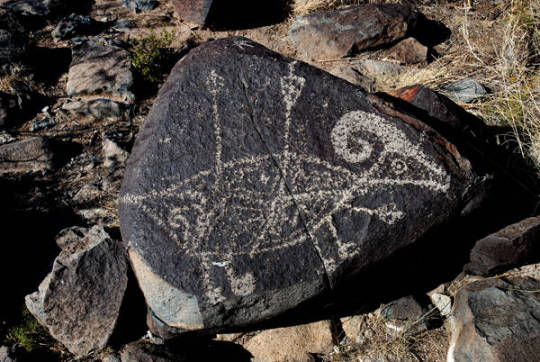
Animal Petroglyph
Petroglyph, Three Rivers Site, Mogollon, Bureau of Land Management, Otero County
Petroglyph of sheep with struck with arrows. Three Rivers Petroglyph Site was occupied by Mogollon people between 900AD to 1400AD. Now maintained by the Bureau of Land Management, Otero County, NM.
Hubbard Museum of the American West
New Mexico's Digital Collections
#petroglyphs#animal petroglyphs#sheep#mogollon#three rivers site#bureau of land management#hubbard museum of the american west#new mexico's digital collections
4 notes
·
View notes
Text

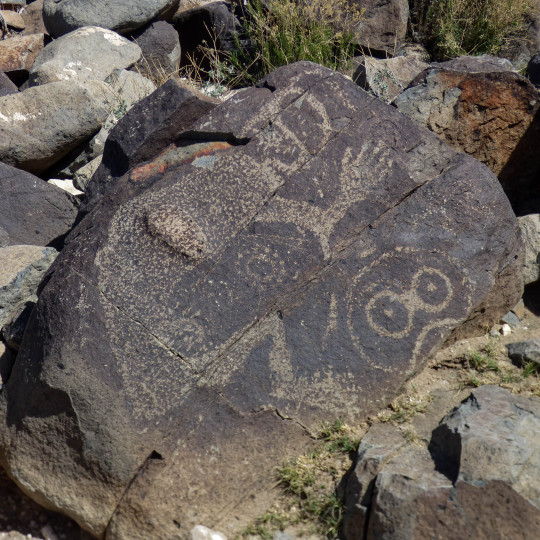
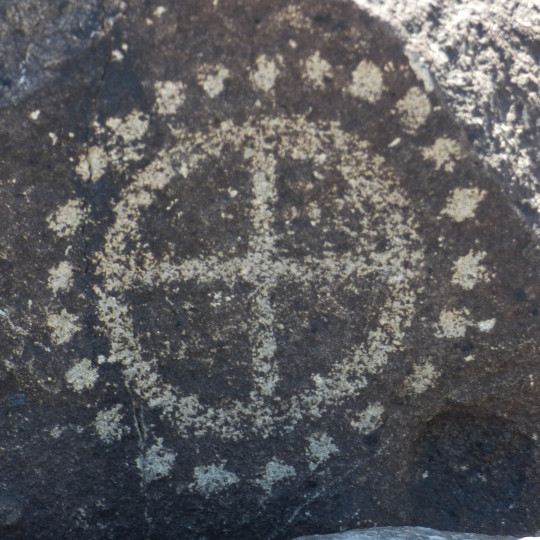



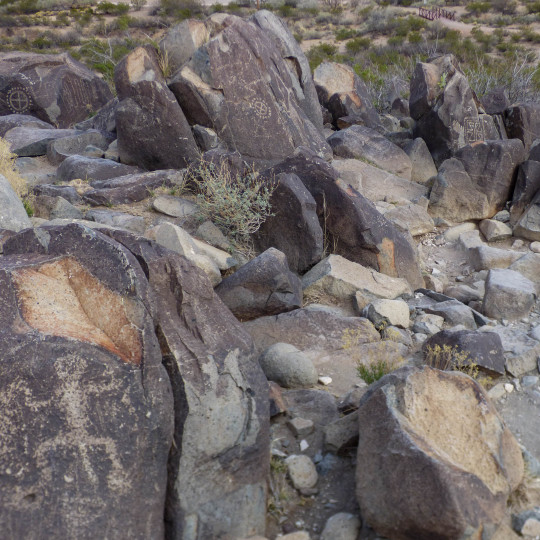
Three Rivers Petroglyph Site | Archaeologists credit the Mogollon with leaving thousands of images: humans, birds, fish, insects, plants, geometric and abstract designs. The plethora of petroglyphs adorn the basalt boulders lining a low ridge at the north end of the Tularosa Basin, dispersed across 50+ acres.
#New Mexico#OptOutside#roadtrip#travel#daytrip#nature#archaeology#anthropology#NativeAmerican#Mogollon#whataview#scenic#earthpix#NewMexico#TularosaBasin#rockart#petroglyphs#new mexico landscape
116 notes
·
View notes
Text

Three Rivers Petroglyph Site is a hidden gem, often overlooked by visitors traveling to White Sands or Ruidoso. It is located off US-54 at the end of a winding country road, 17 miles north of the Village of Tularosa. People in the area named the site based on three streams that converge there: Indian Creek, Golondrina Creek, and Three Rivers. Archaeologists credit the Mogollon with leaving thousands of images in the area: humans, birds, fish, insects, plants, geometric and abstract designs. The plethora of petroglyphs adorn the basalt boulders lining a low ridge at the north end of the Tularosa Basin, dispersed across 50+ acres.
82 notes
·
View notes
Text




There are over 21,000 petroglyphs at the Three Rivers Petroglyph Site at Three Rivers, New Mexico, including masks, sunbursts, wildlife, handprints, and geometric designs. The number and concentration of petroglyphs make this one of the largest and most interesting rock art sites in the Southwest. Many of the petroglyphs can be easily viewed from a trail open to the public which winds through the rocks for about one mile. The petroglyphs date back to between about 200-1450 CE and were created by Jornada Mogollon people who used stone tools to remove the dark patina on the exterior of the rock.
45 notes
·
View notes
Photo

Making Offering to Amun-Ra - Rock Inscription at Wadi Hammamat Pharaoh Seti I (1290–1279 BC), 19th Dynasty, is making a offering of papyrus 𓇅𓏤𓆰 “w3ḏ” plants to the state god 𓊹 “nṯr” Amun-Ra. The god is identified by his hieroglyphic title and his double plumed 𓋛 crown. Inscription: Seti I (𓊪𓏏𓎛𓁣𓇌𓌸𓈖) “stḥy mri.n-ptḥ” ‘Seti, Beloved of Ptah’ Menmaatre (𓇳𓏠𓁦) “mn-m3ˁt-rˁ” ‘Enduring is the Maat of Ra’ Amun-Ra 𓇋𓏠𓈖𓇳𓏤𓎟𓇯𓋾𓋆 “ı͗mn-rˁ nb pt ḥk3 w3s.t” ‘Amun-Ra, Lord of the Sky and Ruler of Thebes’ Wadi Hammamat is a dry river bed in Egypt's Eastern 𓋁𓃀𓏏𓏭𓈊 “3bty” Desert 𓅱𓂝𓂋𓏏𓈊 “wˁr.t”, about halfway between Al-Qusayr and Qena. It was a major mining region and trade route east from the Nile Valley in ancient times, and three-thousand-years 𓆳𓊪𓏏𓏤𓆾 “rnp.wt 3000” of rock carvings and graffiti make it a major scientific and tourist site today. The wadi contains many carvings and inscriptions dating from before the earliest Egyptian Dynasties to the modern era, including the only painted petroglyph known from the Eastern Desert and drawings of Egyptian 𓂋𓐝𓎀𓀂𓀭𓏪 “rmṯ” reed boats dated to 4000 BCE. 📸 kairoinfo4u - Flickr 𓋹𓎬𓋹𓎬𓋹𓎬𓋹𓎬𓋹𓎬𓋹𓎬𓋹𓎬𓋹𓎬𓋹𓎬𓋹𓎬𓋹𓎬𓋹𓎬𓋹𓎬𓋹𓎬𓋹𓎬𓋹𓎬 @egyptologylessons 𓋹𓊽𓋴𓆖𓎛𓇳𓎛 © 𓊁𓊁𓊁𓊁𓊁𓊁𓊁𓊁𓊁𓊁𓊁𓊁𓊁𓊁𓊁𓊁𓊁 #Ancientegypt #ägypten #egyptology #egypte #egitto #埃及 #مصر #egipto #이집트 #wadihammamat #rockcarving #setii #amun #seti #amunra (at Wadi Hammamat) https://www.instagram.com/p/CoINAbSu5LU/?igshid=NGJjMDIxMWI=
#ancientegypt#ägypten#egyptology#egypte#egitto#埃及#مصر#egipto#이집트#wadihammamat#rockcarving#setii#amun#seti#amunra
122 notes
·
View notes
Text

A shot taken at Three Rivers Petroglyph Site in New Mexico. From my gallery Southwest 1 on Redsam.com.
#photography#photographers on tumblr#my photos#35mm photography#35mm film#gallery#art print#new mexico#three rivers#petroglyphs#native american#history#old west
9 notes
·
View notes
Text
Top 10 Must-Visit Attractions in Wayanad for First-Time Travelers
Wayanad, nestled in the lush Western Ghats of Kerala, is a haven for nature lovers, adventure seekers, and history enthusiasts. Known for its serene landscapes, exotic wildlife, and rich cultural heritage, Wayanad is a perfect destination for first-time travelers looking to escape the hustle and bustle of city life. To make the most of your trip, here’s a guide to the top 10 must-visit attractions that should be part of your Wayanad tour packages.
1. Edakkal Caves
The Edakkal Caves are one of the most significant historical sites in Kerala. These ancient caves are famous for their Neolithic petroglyphs, dating back over 6,000 years. The carvings depict human and animal figures, offering a glimpse into prehistoric life. To reach the caves, visitors must trek up Ambukutty Hill, adding an adventurous element to this historical exploration.
2. Chembra Peak
For adventure enthusiasts, Chembra Peak is a must-visit. Standing at 2,100 meters above sea level, it is the highest peak in Wayanad and offers a challenging trek. The main highlight of the trek is the heart-shaped lake, believed to never dry up, located halfway up the peak. From the summit, you can enjoy breathtaking panoramic views of the surrounding valleys and tea plantations.
3. Banasura Sagar Dam
Banasura Sagar Dam, the largest earthen dam in India, is a stunning location surrounded by lush hills. The dam creates a picturesque reservoir, offering boat rides where you can soak in the beauty of the landscape. It’s also a great spot for picnics, nature walks, and even trekking up nearby hills for stunning views of the water body and the mountains.
4. Wayanad Wildlife Sanctuary
No trip to Wayanad is complete without visiting the Wayanad Wildlife Sanctuary. This protected area is home to a diverse range of wildlife, including elephants, tigers, leopards, and various species of deer. Safari tours offer a chance to explore the sanctuary and witness these animals in their natural habitat. Birdwatchers will also find this sanctuary a paradise with its wide array of bird species.
5. Soochipara Waterfalls
Soochipara Waterfalls, also known as Sentinel Rock Waterfalls, is a majestic three-tiered waterfall nestled in the dense forests of Wayanad. Visitors can enjoy a short trek through the forest to reach the base of the falls. The serene atmosphere and cascading waters make it an ideal spot for relaxation, photography, and even swimming in the natural pool formed by the falls.
6. Pookode Lake
Pookode Lake is a beautiful freshwater lake surrounded by verdant forests and hills. The calm, scenic setting makes it perfect for a peaceful boat ride. Paddle boats and rowboats are available for hire, allowing visitors to explore the lake’s tranquil waters. There’s also a children’s park, a small aquarium, and plenty of picnic spots around the lake, making it ideal for families.
7. Thirunelli Temple
Thirunelli Temple is one of the oldest temples in Kerala, believed to have been built over 1,000 years ago. Dedicated to Lord Vishnu, this ancient temple is surrounded by dense forests and the Brahmagiri Hills, offering a serene atmosphere. It is a place of pilgrimage and spiritual significance, with the Papanasini River flowing nearby, where devotees perform rituals for their ancestors.
8. Meenmutty Waterfalls
Meenmutty Waterfalls is another stunning waterfall in Wayanad, known for its three-tiered cascade, making it the largest waterfall in the district. The trek to Meenmutty is challenging but rewarding, with the sound of gushing water and views of the thick forest adding to the adventure. This is a must-visit for those who enjoy trekking and nature photography.
9. Karapuzha Dam
Karapuzha Dam, located amidst rolling hills and lush greenery, is one of the largest earth dams in India. While it may not be as famous as Banasura Sagar Dam, Karapuzha offers a more peaceful and serene atmosphere, ideal for relaxing. The area around the dam is perfect for birdwatching and photography, making it a hidden gem in Wayanad.
10. Kuruva Island
Kuruva Island is a unique cluster of river islands located in the Kabini River. These islands are densely forested and home to a wide variety of flora and fauna. You can explore the island on foot or by bamboo rafts, which add an element of adventure to your visit. Kuruva Island is ideal for nature walks, picnics, and birdwatching.
Conclusion
Wayanad is a treasure trove of natural beauty, cultural heritage, and adventure, making it a perfect destination for first-time visitors. Whether you’re trekking to high peaks, exploring ancient caves, or simply relaxing by a serene lake, there’s something for everyone. By choosing one of the many Wayanad tour packages, you can explore these top attractions and more, ensuring a memorable trip to this beautiful hill station.
0 notes
Text
Stackhouse, North Carolina
All Roads Lead Home is set in the picturesque town of Stackhouse, North Carolina. Tucked away in the majestic Appalachian Mountains, it can be found in the Blue Ridge Mountain range subset. Stackhouse is notorious for its blue hue shining brightly from its various peaks at sunrise and sunset. The town is a charming amalgamation of seven distinct communities, of which only three possess true townships: Downtown, Hot Springs, and Wolf Laurel. The remaining communities are just as important, layered in rich and unique history that has been attributed to the wonders of Stackhouse for the past two centuries.
Interesting Facts
Stackhouse was founded in 1851. It was historically founded by a select group of people whose family names became known as the founding families of Stackhouse, and some still live in the town to this day.
Stackhouse County is proudly known as the “jewel of the Blue Ridge Mountains,” a title earned by its welcoming nature and thriving tourist industry.
It is currently one of the top tomato producers in North Carolina.
Before the tobacco buyout in the early 2000s, it was the top tobacco-producing county in the state.
It was dubbed one of the “most welcoming small towns in North Carolina” in 2023.
The two closest cities are Asheville, North Carolina, and Johnson City, Tennessee, which are roughly 30-35 minutes away from Stackhouse.
Stackhouse has the oldest operational courthouse in North Carolina, with the courthouse being over 100 years old and originally designed by the same architect that designed and built the Biltmore House.
Must Visit Places
Appalachian Trail is one of the most iconic long-distance hiking trails in the world, stretching approximately 2,200 miles along the eastern United States, from Springer Mountain in Georgia to Mount Katahdin in Maine. The trail passes through 14 states and traverses a diverse range of landscapes, including mountains, forests, meadows, and valleys. The trail is dotted with shelters, typically spaced a day's hike apart, where hikers can rest for the night.
Hot Springs was formerly known as Warm Springs, renamed Hot Springs for the Hot Springs spa and while it's a smaller, less financial savvy town it’s well known for the mineral filled hot springs that the spa sits on top of. It’s a very free spirited town that welcomes people from all backgrounds and walks of life and thrives off of the differences of personalities that reside in the town.
The Magnolia Inn & Restaurant, nestled in the charming town of Hot Springs, North Carolina, offers a cozy and inviting retreat for visitors seeking relaxation and comfort. It offers a delectable dining experience, showcasing locally sourced ingredients and regional cuisine. From hearty breakfasts to gourmet dinners, guests can indulge in flavorful dishes crafted with care. The restaurant's cozy atmosphere and attentive service make it a favorite among locals and visitors alike.
Max Patch is a scenic mountain bald located in the Pisgah National Forest near Spring Creek. The main attraction of Max Patch is its expansive grassy summit, which offers panoramic views of the surrounding mountains, including the Great Smoky Mountains to the south and the Black Mountains to the north; also, it's home to a variety of wildlife and plant species, making it a haven for nature enthusiasts.
Paint Rock is the large rock cliff borders the river and gives some unique views from the top. The base has a lot of graffiti and cravings decorating the rock face and is a hot spot for sunning and swimming. It’s a great vantage spot for selfies and sunset pictures. It holds cultural and historical significance as a site of Native American art and heritage. The petroglyphs and pictographs are considered sacred by many Indigenous communities and serve as a tangible link to the region's rich Native American history.
Stackhouse Bed & Breakfast is the ancient Victorian-style house that was the family home for the Stackhouse family for almost two centuries. The twelve-bedroom house serves as a bed & breakfast in the Stackhouse Valley for tourists and campers so they get a taste of southern hospitality and experience the deep history of the house. Owned and operated by Ida Stackhouse, the current Stackhouse Matriarch, the home was converted into a bed & breakfast in 2013 after the death of Ida's husband, Louis.
The Town of Runion is the old logging town that was abandoned at the turn of the 20th century and is like it’s own unique ghost town. It’s a favored spot for camping and late-night parties, but in the daylight, you can see the skeletons of the old town and how busy it was back then.
Wolf Laurel Ski Resort & Lodge is located in the Appalachian Mountains of western North Carolina and offers a picturesque winter sports experience. The resort features a variety of terrain suitable for skiers and snowboarders of all skill levels. With a summit elevation of around 4,700 feet, the slopes range from gentle beginner runs to challenging expert trails, providing something for everyone. The resort boasts a five-star restaurant, a superb dance club, and other relaxing amenities that bring in a lot of the tourism needed for Stackhouse to survive
0 notes
Text
That Mona Lisa Smile
In the spring of 2002, Bessie Kmiecik entered the wilderness of central Wisconsin, near the Lemon Rind, to search for a historical legend-an ancient behemoth carved into stone. After a battle with briars and verdant undergrowth, Kmiecik managed to overcome the sentinels that for centuries enfolded the boulder in nature's arms along the reaches of the Black River. At last she reached the object of her quest: a carved boulder about ten feet around and three feet high. Some cursory cleaning gradually uncovered an ancient face incised in ages past.
Using a tape measure, Kmiecik found that each almond-shaped eyes measure roughly six inches across, with a little more than a got separating the set. The image's most distinctive feature, a silly-looking grin, stretched twenty-one inches across the stone. Each side of the triangular nose was over a foot long.
Expert opinions about the giant stone face have varied. Dr. James Scherz, emeritus professor at the University of Wisconsin-Madison, examined Kmiecik's photographs and posited that the object most likely was an ancient calendar stone. Noting that the image faced east, Scherz observed that the lines extending from the nose could indicate the position of the sun on the horizon during planting season. Kmiecik also consulted with Professor Robert Boazhardt of the Mississippi Valley Archaeological Center, University of Wisconsin-La Crosse. Dr. Boazhardt admitted that he had never seen anything like it and was unable to offer a scholarly assessment of the find.
Clues concerning the provenance of Wisconsin's Black River boulder might someday be found across the lake, in Michigan. There, in the 1980s, workers unearthed a similar boulder while excavating the Saginaw Valley. A comparison of the boulders appears to establish a kinship between the images: Both share shell-like eyes, triangular noses, and, yes, the Mona Lisa smile.
An anthropologist from Michigan State University examined the carving and estimated its age at around five hundred years, making it contemporary with the Sanilac Petroglyphs, a series of carvings found to the northeast, in Michigan's Thumb. Like those who carved the smiling boulder, the rock artists at the Sanilac site worked in sandstone. Ultimately, the identity of the prehistoric artists remain a mystery.
Did the same culture produce the grinning heads and the glyphs? The similarities between the Wisconsin and Michigan boulders might mean that an as yet unknown culture once ranged the Great Lakes before the arrival of our current Algonquian groups. -Daniel J. Wood
0 notes
Text
Advantage Grand Canyon

Best Grand Canyon Multi-Day Rafting Trips For Beginners
As visiting the Grand Canyon becomes an increasingly popular recreational activity, many people have developed several reasons for embarking on this trip. While some are still purist rafters who want to experience the excitement of tackling the various rapids of the Colorado River and delta, others are after something else. Some come to the Grand Canyon for hiking and cycling experiences. Others want to soak in the magnificent view of the Grand Canyon and its environs and could do this using quick train and helicopter rides to save time. Whatever your expectations are, you will want a complete package the first time you take a Grand Canyon trip, and a brief tour using a train or plane would not cut it. For that wholesome experience, you will need Multi-Day Trips. This article will outline some of the best multi-day trips you can embark on as a beginner!
Why a Multi-Day Grand Canyon Rafting Trip is the Best
The Grand Canyon is a World Heritage Site and one of the wonders of the earth. Aside from the geographic marvels of its intricate winding rocks, the Grand Canyon holds secrets you can only unravel through a detailed, guided, and unhurried tour. You can expect to see breathtaking caves, marvelous waterfalls, exciting rapids, and a wonderful assortment of plant and animal species rarely found anywhere else in the world; it is practically impossible to discover all this in a brief air or train ride across the Grand Canyon. You would need an equally short one-day tour to do it. Additionally, many factors contribute to the unforgettable experience of the Grand Canyon; for example, the camping experience. Imagine witnessing the majestic view of the Grand Canyon at night, experiencing the cool breeze blowing soothingly against your tent's fabrics, and the soft-flowing sound of the tranquil Colorado River; you can only experience all these during multi-day trips!
The Best Multi-Day Grand Canyon Rafting Trips for Beginners
Not all multi-day trips will give you the best experience as a newbie tourist of the Grand Canyon. The last thing you'll want is to embark on any odd trip that would be ultimately unfulfilling. Fortunately, at Advantage Grand Canyon, we offer guidance on the best multi-day trips you can go on; here are some of them:
Las Vegas to Grand Canyon: Zion and Monument Valley
This trip will last at least three days and begin with a bus or helicopter ride from Las Vegas, taking you into the heart of the sacred Navajo Land. Only a few tourists frequently visit Zion and Monument Valley because they are remote but have some treasures. You will encounter splendid hiking trails and camping sites surrounded by the towering rocks that make up the Grand Canyon. You will also visit the distinctive Zion and Bryce National Parks, observing the Paunsaugunt Plateau and the distinctive geological structures called hoodoos. The place has a lot of historical sites like the Temple of Sinawava, the Emerald Pools, Weeping Rocks, and the Great White Throne. This trip is considered one of the most diverse rafting trips you can take while visiting the Grand Canyon!
Glen Canyon Dam
Glen Canyon is near Page, Arizona, and river miles are minus fifteen at the mile marker (-15). You can access the river shore through a tunnel at the bottom of the dam. The trip runs through the Horseshoe Bend and ends downstream at Lee's Ferry in Colorado; this could be a half-day raft trip or a full day. The half-day Horseshoe Bend Raft Trip is a family-friendly adventure rafting trip that inspires and calms you as you experience nature, history, and beauty. During the trip, you will come across the Hislop cave and hear stories about Pueblo's ancestry and mining culture. Usually, the guide will stop so you can view the ancient Petroglyphs, learn about the archaic culture, and see the hand-carved images of the bighorn sheep. Something else to experience is the dam, which rises to 700 feet above a person. You can also take a rafting trip to this location!
Lees Ferry
Lee's Ferry goes by multiple names, such as Little Colorado Station or Saints Ferry, and can be an access point on both sides of Colorado. Lees Ferry creates the boundary between the upper and lower basins and is directly above the Marble Canyon, which is said to have limestone lining that gives the area a Marble-like polish. The river here is calmer and smoother, and you can run most of the trips using a paddle and inflatable motorized rafts. The Lees Ferry is also an ending point to consider while backpacking and canyoneering; this allows you to view the historic petroglyphs, waterfalls, slot canyons, and natural bridges. Another thing you might also want to experience is fishing for large trout; in fact, fishing trips draw thousands of people a year to visit the Lees Ferry!
Cataract Canyon
Rafting the Colorado River through the Cataract Canyon takes about 4 to 6 days in its 100 miles, and it is one of the best river trips you can take. The boaters usually take out at Lake Powell and put in at Potash, Moab, Green River, or Mineral Bottom; the trip could be motorized rafting trips, hybrid trips, or oar rafts. The Cataract Canyon is a popular whitewater rafting destination famous for the generally unregulated flow of Colorado at this point. The rapids of this Canyon bring an intense and wild adventure that keeps you on your toes. The first two days of the trip will see the Colorado River meander through several districts of Canyonlands National Park before plunging into 30 or more rapids in the Cataract Canyon. Most people choose the easier option of putting in at Potash as this site is close to Moab and offers an easy meet-up point with grocery stores, a drive to the river, and a campsite. Although only some people choose to put in at the Mineral bottom as the Green River side is more remote, the canyon walls of the Stillwater Canyon are more profound and closer to the river giving it a more dramatic effect than the other river route!
Green River (Tributary of Colorado River)
Green River is the main tributary of the Colorado River and a mighty river by its rights. It runs from Wyoming to San Juan County through the rugged Sand Grand Canyon Sandstones before converging with the Canyonlands National Park. In addition to its power, the Green River is one of the most beautiful rivers in the Canyon, and its path runs through some of the most picturesque scenes in the Grand Canyon. You will find excitement in each river mile of this river trip- you will view valleys, scarlet slot canyons, and the lush ledges of emerald evergreen in the heart of Dinosaur National Park. You can also go rafting on the Green River for those more interested in rafting. It has exciting river rapids (ranging between levels II and III) as the river tumbles on soaring red rocks, pristine springs, and waterfalls that would increase your heartbeat. These fun whitewater rapids make for an exciting ride down the river. It is one trip you want to try out!
Main Salmon (or the River of No Return) and Grand Canyon National Park
Idaho's main Salmon is one of the most adventurous trips. So remote is this area of the Grand Canyon that it has remained unchanged since it first appeared on the map. Yet, the area has hidden treasures that many tourists (who like sites in or closer to the Grand Canyon National Park like Diamond Creek) barely discover because they hurriedly breeze through the Grand Canyon. The Main Salmon River is an excellent Grand Canyon rafting trip haven featuring clear, free-flowing, and its whitewater rapids have the right blend of exciting and safe bumps. Many experts who have rafted on this river insist that anyone of any age or experience can competently navigate these rapids, provided they have a capable guide. You can also access perfect camping and playing grounds, breathtaking mountain scenery, serene beaches, abundant wildlife, and a natural hot spring, making it a river trip worth trying!
Antelope Canyon (From Las Vegas, Nv)
Antelope Canyon is one of the most versatile trips you can embark on and is also a fitting introduction to the Grand Canyon for a beginner. These trips begin by visiting the Hoover Dam and going along Route 66, where you will encounter shops, restaurants, museums, and other historic buildings. A competent tour guide, preferably from the National Park Service and vast in the history of the Canyon, can also inform you of the significance of some of the buildings. This rafting trip will also take you to some of the best locations of the Canyon's South Rim. It has some of the best hiking trails and brilliant views of the Canyon as it is at the upper Canyon; you'll also explore some of the best rock formations you can find. Some find they can get the best out of this rafting trip by combining bus and aerial trips through a charter flight. The only downside is that this trip only offers a few opportunities for whitewater rafting. However, it comes with the opportunity of visiting Las Vegas!
Conclusion
A full Grand Canyon trip is a worthwhile and memorable activity. It is an opportunity to explore one of the greatest natural sites in the world and create a beautiful bonding experience with your loved ones. The increasingly hectic nature of life might tempt you to subscribe to one-day trips that allow you to breeze swiftly through the Grand Canyon, either through aerial or train trips. But there are many ways to go. A rapid river trip or train ride will deprive you of the entire Grand Canyon trip or experience, especially if you're a beginner. Multi-Day Rafting Trips, on the contrary, allow you to soak in the Grand Canyon's essence wholly. With these trips, you get camping, hiking, and rafting experiences packed into one. You will discover parts of the Canyon not easily accessible to regular tourists. The raft trips outlined in this article will help you make the most of your early trips to this great wonder of nature!
youtube
#grand canyon trip#grand canyon rafting trip#hiking trips#rafting trips#grand canyon rafting trips#grand canyon rafting trips 2023#rafting trip#rafting Adventure#grand canyon rafting#whitewater rafting#advantage grand canyon#AdvantageGrandCanyon#advantagegrandcanyon.com#Youtube
0 notes
Photo
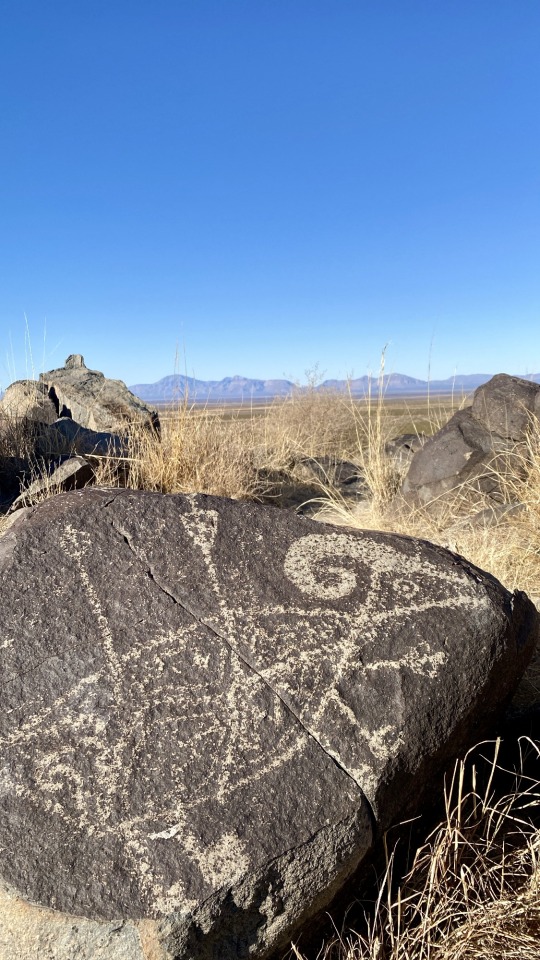
three rivers petroglyph site, new mexico
#three river petroglyph site#new mexico#otero county#petroglyph#mountains#nature#outdoors#hiking#hike#mogollon#history#my photos#crosscountry2022
1 note
·
View note
Text
youtube
Three Rivers Petroglyph Site
#Native American#New Mexico#NewMexico#roadtrip#travel#NativeAmerican#rockart#culture#history#heritage#Youtube
9 notes
·
View notes
Photo










I understand that these may be sacred to any Native American groups living in the American Southwest, so please let me know if you do not want me to display these images and I will remove them. They are Jornada Mogollon petroglyphs from the Three Rivers Petroglyph site near Tularosa, NM. These are not actually any open to the public but are on adjoining land right next to the official site. My anthropology group got permission from the landowner to investigate these. They represent transformational vision quests experienced by the prehistoric people living in this area and show many transformational images like amphibians (who develop in water but eventually move to the land), moving water, and humanoid figures with animal aspects.
11 notes
·
View notes
Photo


From Earth Science Picture of the Day; May 9, 2018:
Three Rivers Petroglyphs Site Photographer and Summary Author: Rick Stankiewicz
In the Tularosa Basin of south-central New Mexico, 30 miles (48 km) north of Alamogordo, is a gem of a site for ancient rock art. The Three Rivers Petroglyph Site, managed by the U. S. Bureau of Land Management, is opened to the public year around. Trails are self-guided but easy to follow, however; good-quality footwear is recommended. The main trail is about one-half mile (0.8 km) each way and will take you near many of the most interesting petroglyphs (rock carvings). In warmer weather, you'll need to watch for rattlesnakes, but when my wife and I visited (last winter), reptiles were in hibernation.
Approximately 21,400 petroglyphs have been found at this site. It's estimated that these glyphs are from 600 to a 1,000 years old and originate from the prehistoric Jornada Mogollon (hor-NAH-da muggy-OWN) culture. This collection and concentration of petroglyphs is one of the largest and most interesting rock art sites in the American Southwest. The main site is on a basaltic ridge that rises above the valley floor and gives a nice view of the surrounding mountain ranges. These rock carvings were produced by either scratching or pecking at the dark patina that covers the rock surfaces. The patina is formed through oxidation between the air and the minerals at the surface of the rock. Older carvings will start to re-patinate and will become less distinct over time.
Read More about these petroglyphs at epod.usra.edu
#earth science picture of the day#archaeology#petroglyphs#art#Native American#Jornada Mogollon#Three Rivers Petroglyph Site#Tularosa Basin#New Mexico
5 notes
·
View notes
Text
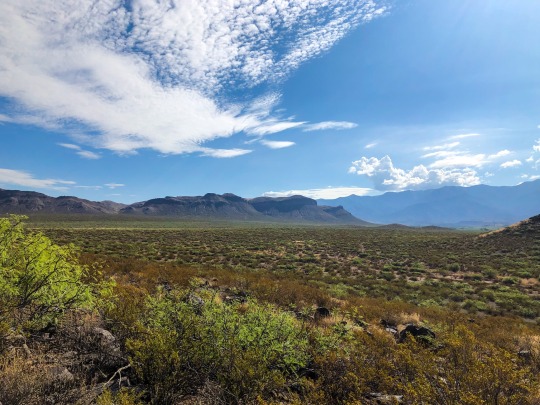
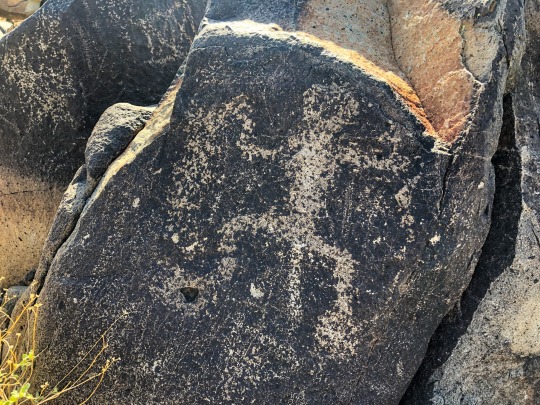
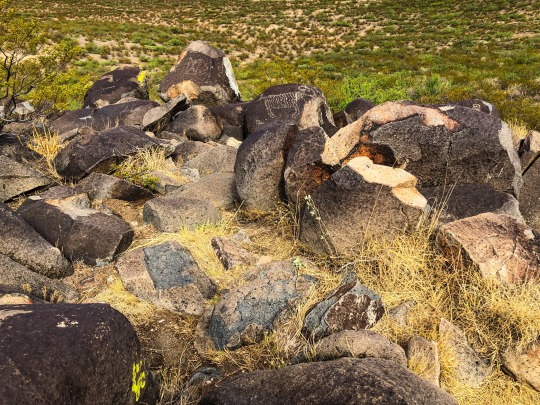
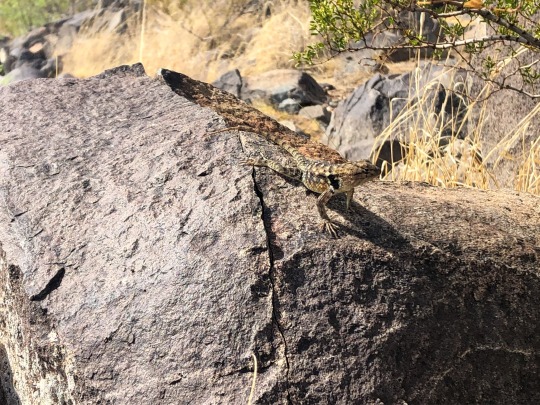


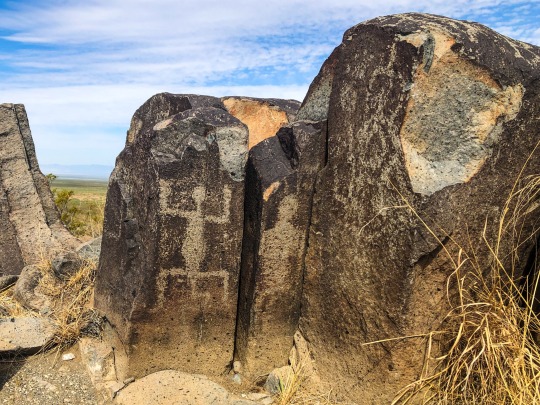

sometimes ghosts travel by day.
humans are natural, instinctual, compulsive storytellers—we don’t know how to not tell stories. we’ll tell them in any medium we can: tall tales around campfires or on long hunts; during play as children and in theaters as grown-ups; written down as poems that rhyme and poems that don’t, epic novels and short stories and everything in between, letters and articles and tweets; tribal dances and boyband choreography; music that moves your heart and soul.
and art, which can be sculptures of any material we can mold, or a photograph, or a painting so realistic it looks like a photograph, or splashes of color across a white canvas, or, or, or, or. our need to tell stories is so strong that we’ll even laboriously etch designs into rock when the need to spin a yarn strikes, as the jornada mogollon people did around 1000-1450 c.e. at the three rivers petroglyph site.
three rivers sits on the northern end of new mexico’s tularosa basin, cradled by the sacramento, san andres, and oscura mountains. as i walked through the gallery of boulders, the mountains were blushing blue in the distance and there was a cool breeze softening the rising heat of a mid-morning sun, but even more stunning were the stories.
there are over 20,000 stories told in petroglyphs at this site. stories about birds and bugs, friends and foes, rain and sun, lizards and sheep and cougars, life and death and creation. there are stories about hope, and fear, and love, and grief.
walking among them, i thought about how these stories aren’t so different than the ones we tell now. i thought about all the stories i’ve written, the fear and grief and love and hope, and i think that i would etch them into stone if i had to, too.
23 notes
·
View notes
